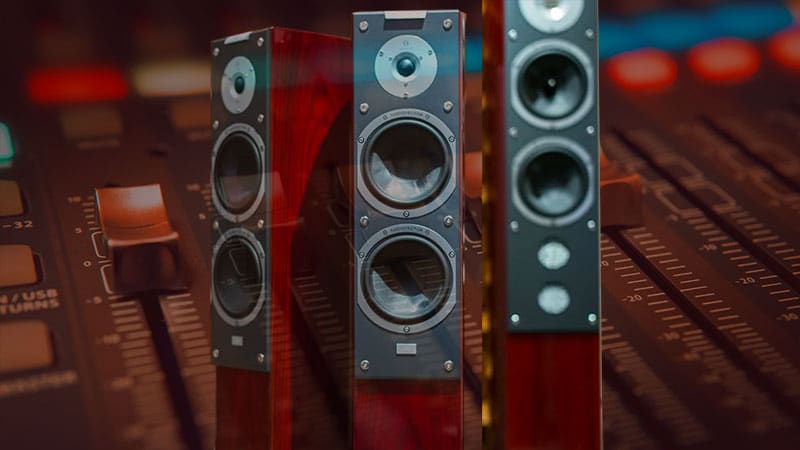The factor that brings big-screen action to life is surround sound. Surround speakers are the rear speakers in a surround sound system behind the listener. The reason is that they are in charge of a film or game’s mood and sound effects. The rear speakers, mixed for multi-channel surround sound, play back the sounds that set the scene: an indistinct murmur of voices in a vast structure, the roar of the ocean, and the tweeting of birds. As a result, surround speakers are also referred to as back effect speakers.
Surround sound has taken hold in the home theatre, but it is useful anyplace you watch TV-based media or listen to music.
Why are Surround Speakers so Important
Consider a movie scene set in a large workplace. The voices of two coworkers can be heard clearly from the center speaker as they converse. We also hear other sounds in the background, the gentle clicking of fingers as they move across keyboards, telephones ringing, and coughing. The direct sound of the voices speaking to us from the center and front speakers, along with the surround noises, gives us a real sense of the atmosphere.
A sound system can only provide a real impact if the noises we hear seem to surround us rather than radiate from the front. Surround speakers are responsible for making good home cinema sound genuinely immersive.
How Does Surround Sound Work?
Surround sound systems give listeners a sense of realism. You feel like you’re in the movie when you hear surround sound. You’ll need three things for surround sound to work: media with audio blended for surround sound, an excellent audiovisual (AV) receiver, and a variety of speakers strategically placed around your sitting area.
To completely comprehend how a surround sound system works, let us first discuss conventional surround sound formats, then move on to various surround sound components, and finally to standard speaker placements.
How Many Does One Need?
Two rear speakers are usual in a 5.1 surround sound system. Four are available on larger 7.1 systems. Including two surround speakers enhances the soundstage and increases the sweet spot. Soundtracks in the Dolby TrueHD and DTS-HD Master Audio formats are combined using these extra channels. Upcoming releases by The Beatles and Kiss are among the major artists who have remixed back catalogue projects for surround sound.
Surround speakers should be placed equidistant to the listener on either side and behind the listening position. In a 7.1 system, this symmetry should also be observed with the two additional surround speakers. The ideal height for surround speakers will differ depending on the system. In most circumstances, however, a height between 1.4 and 2.1 meters above the sitting listener’s head is ideal. It can be accomplished by either mounting the speakers on the wall or placing them on speaker stands.
Most Common Surround Sound Configurations
You may have heard the words “5.1,” “7.1,” or even “9.1.2” when referring to surround sound. You might think it’s a version number, but it’s only a naming convention for knowing how many speakers are at different heights in a room.
Surround Sound 5.1
The most common surround sound speaker arrangement is 5.1 Surround Sound. Many homes utilize this surround sound arrangement since it requires the fewest speakers while providing a realistic surround sound experience. Five speakers and a subwoofer make up this system.
Surround Sound 7.1
Surround Sound 7.1 is a natural progression from surround sound 5.1. This setup offers an even more convincing surround sound experience with just two more speakers. This system has the same format as 5.1, and two additional satellite speakers are located to the spectator’s sides.
Surround Sound 9.2.2
9.2.2 Surround Sound employs nine ear-level speakers, two subwoofers, and two overhead or ceiling speakers. This surround sound system is suited for larger areas where ear-level speakers cannot be placed in the middle of the room. Furthermore, the additional subwoofer and ceiling speakers deliver a consistent surround sound experience around the space.
Surround Systems for Gaming
Everyone is talking about purchasing a new TV for their PS5 or PC, and HDR will undoubtedly make your games seem better. Surround sound, on the other hand, is an equally remarkable boost, whether you’re playing cinematic masterpieces like God of War or the 5v5 character-based tactical FPS Valorant.
Virtual and True surround sound are the two types of surround sound. Both sorts may aid gamers depending on the situation and even give them a competitive advantage. The fundamental objective of surround sound is to offer an extra level of immersion, which might be advantageous in particular scenarios.
Riot Games integrated HRTF Audio to Valorant in Patch 2.06, intending to provide players with a far better audio experience. HRTF Audio in Valorant is intended to provide a “3D” audio experience, and you should be able to detect adversaries more quickly based on gaming sounds. The difference will be evident if you have a surround-sound audio setup.
Did you ever wonder why professional players on Valorant pro scene always have headphones? It’s because the headphones have a built-in surround system. However, you do not exactly need headphones for gaming if you have a surround system in place. It will feel just as if you have headphones on your head. You will be able to hear the exact direction the enemy is coming from, which is amazing considering that you aren’t wearing any headphones. Instead, your room surround system is designed like one.
Conclusion
We’ve compiled a pretty detailed essay on what and how to use surround sound. Don’t settle for a sound bar if you want an authentic home theatre experience or the most outstanding gaming experience—go for the complete multi-channel.





